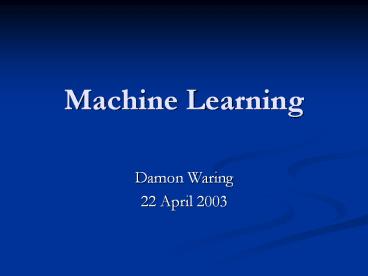Machine Learning - PowerPoint PPT Presentation
1 / 15
Title: Machine Learning
1
Machine Learning
- Damon Waring
- 22 April 2003
2
Agenda
- Problem, Solution, Benefits
- Machine Learning Overview/Basics
- Face detection, recognition, and demo
- How this applies to us
- Summary
3
Problem
- Software frequently requires users or developers
to do simple, repetitive tasks
4
Solution
- Machine Learning
- The study of computer algorithms that improve
automatically through experience Tom Mitchell,
Machine Learning - Machine learning uses include
- Security (Pattern recognition, face recognition)
- Business (Stocks, user behaviors)
- Medical (Research)
- Ease of Use (Focus of this presentation)
Algorithms that execute based on experience
5
Benefits
- Makes human-computer interaction easier
- Relatively simple to integrate
- Will distinguish your product from others
- Increase customer satisfaction
- Will improve simple intelligent systems (ex
Microsoft Words grammar checker)
Enhances the user experience
6
High Level OperationRecognition Algorithms
- Training Mode
- Training Set
- Iteratively analyze inputs and refine algorithm
- Store learned data
- Operation Mode
- New input
- Process input using learned data
- Produce a decision
Learn from nature. It has had 4 billion years
to develop its techniques My Dad
Recognition algorithms are taught and react like
humans
7
Case Study Artificial Neural Network
- Takes N inputs
- Calculates the weight each input has on final
decision - Neuron outputs a 1 if the decision is true, 0 if
it is false - Groups of neurons make up an artificial neural
network
Group of weighted input values determine a binary
output
8
Face Detection
- Image pyramid used to locate faces of different
sizes - Image lighting compensation
- Neural Network detects rotation of face candidate
- Final face candidate de-rotated ready for
detection
9
Face Detection (Cont)
- Submit image to Neural Network
- Break image into segments
- Each segment is a unique input to the network
- Each segment looks for certain patterns (eyes,
mouth, etc) - Output is likelihood of a face
10
Face Recognition and demo
- Demo Hidden Markov Model Face Recognition
- Observes location of facial features with respect
to each other - Person is found through unique fingerprint
created by distances between features - Demo is from OpenCV Intels open source
computer vision library
Implementations vary widely and have different
success rates
11
Adobe Photoshop Album
- Software that organizes digital pictures
- Tags are dragged to each photo to categorize it
- Tagging 100s of photos is tedious
- Face recognition could automatically tag photos
or replace tags altogether
Machine learning can be used to make everyday
apps easier
12
Current Uses of ML
- DivX Face detection
- POV-Ray Neural Net learns memory accesses
- Ancestry.com Uses Optical Character Recognition
to digitize newspapers - Deep Blue Junior Less powerful than Deep Blue,
but smarter because of Neural Networks
13
Other Areas
- Artificial Intelligence (AI)
- Data Mining
- Fuzzy Logic
- Optical Character Recognition (OCR)
14
Summary
- Machine learning is possible today
- Large amounts of research are available
- Quality open source code available in some areas
- Will require time and creativity to implement
- Why do it? Makes human-computer interface simpler
15
References
- Books
- Machine Learning by Tom Mitchell
(http//www-2.cs.cmu.edu/tom/mlbook.html) - Web sites
- Hidden Markov Models http//jedlik.phy.bme.hu/ger
janos/HMM/node2.html - Links recommended by PCAI http//www.ics.uci.edu/
mlearn/MLOther.html - CMUs research areas (scroll down)
http//www.ri.cmu.edu/people/kanade_takeo.html - MITs Media Lab http//www.media.mit.edu/
- Computer vision links http//www-2.cs.cmu.edu/afs
/cs/project/cil/ftp/html/vision.html - Open source computer vision library (OpenCV)
http//sourceforge.net/projects/opencvlibrary/ - Journals
- PCAI (a great industry magazine, web site is
bad)- http//www.pcai.com - ScienceDirect (http//www.sciencedirect.com)
Computer Vision and Image Understanding,
Artificial Intelligence, Neural Networks - IEEE Proceedings (http//www.ieee.org) Pattern
Analysis and Machine Intelligence, Image
Processing - IEEE Papers/Proceedings referenced in this
presentation - Hidden Markov Models (used in OpenCV Demo)
Maximum likelihood training of the embedded HMM
for face detection and recognition. Nefian,
A.V. Hayes, M.H. III Image Processing, 2000.
Proceedings. 2000 International Conference on,
Volume 1, Pages 33-36. - Neural network-based face detection. Rowley,
H.A. Baluja, S. Kanade, T Pattern Analysis and
Machine Intelligence, IEEE Transactions on,
Volume 20 Issue 1, Jan 1998. Pages 23-38. (Paper
posted at http//www.ri.cmu.edu/projects/project_
271.html) - Rotation Invariant Neural Network-Based Face
Detection http//www.ri.cmu.edu/projects/project_
271.html































